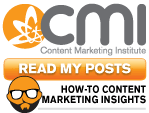Behavioral norms are at the core of our humanity; we are hardwired to behave in a certain way, particularly for decision making. They have even affected the
phenomenal success of social networks [see BJ Fogg's Persuasive Bathroom Epiphany: MarketingProfs Digital Marketing Mixer 09].
Furthermore, the average America sees approximately 5000 marketing messages per day; we're constantly bombarded with information. No wonder we look for shortcuts!
[Nancy referred to Paco Underhill, author of Why We Buy: The Science Of Shopping
Here are Nancy Harhut's 13 choice drivers or automatic behaviors that people embrace. Imagine applying these to your business to improve the rate with which potential customers interact with and respond to your marketing....
1. People respect authority. They will scan to determine if they NEED to read. They will defer to people whom they perceive to be authority figures.
2. Humans are naturally curious. How might you stand out? [e.g., Imagine receiving a Coconut mailer for a medical conference in Hawaii. Bet you would remember that!]
3. Gatekeepers make very deliberate assumptions. They want to avoid blame. If it looks important, they will assume it is. If they make a decision once, they tend to fall into that pattern.
4. People look at who and where mail is from.
5. We’re inclined to touch things. Interaction increases response rate/engagement.
6. Our eyes gravitate to certain words. Eye magnet words: “Free”, announcing, new, finally, soon, introducing [used in high priority content real-estate], you, person’s name
7. No – really can mean ‘tell me more’. People buy solutions to problems, so maybe the first contact didn’t connect. Try again.
8. Some responses are automatic. For example, “compliance triggers” produce automatic yes. Coupon or rather dashed line that surrounds coupon will lift readership by 23% regardless of value, telling people 'because' leads to compliance. Easy, quick, improved will increase product sales. LONG copy – trustworthy compared to short messages.
9. People are most interested in themselves. We lose people when we focus too much on ourselves. Give people something. Help people fix a problem. Deliver good news. Feel superior. Share something that you aren’t supposed to hear.
10. People make decisions for rational and emotional reasons. You need to address both sides of argument.
11. Avoidance of pain. More powerful motivator than achievement of pleasure. Loss can be twice as powerful a motivator as gain.
12. People feel obligated. The principle of reciprocity – we like to pay in kind what someone does for us. We also want what we cannot have. Principle of scarcity: if it's scarce – we want it.
13. We do what people like us and people we like do. The Principle of Social Proof: we mirror other people’s actions. This is why testimonials are so effective, particularly if:
- They come from a person similar to the person we are trying to convince – horizontal influence
- Most convincing if the testimonial suggests. It starts where the prospect is and moves them along.
- If you don’t use someone like your prospect, use someone your prospect likes.
This video of Nancy, despite the introduction in Portuguese, gives you a feel for some of the perspective Nancy offered us during this MarketingProfs B2B Forum presentation.
Thanks, Nancy, for a thought-provoking session!
How might you apply your awareness of these behaviors to your communications with customers? What about some of the direct mail or email communications you've received? Where you aware of responding in one of the ways described above? I know I'm going to be paying closer attention!
--
If you enjoyed this post, consider subscribing to Simple Marketing Blog via email updates or RSS.









No comments:
Post a Comment
Reminder: Please, no self-promotional or SPAM comments. Don't bother if you're simply trying to build inauthentic link juice. Finally, don't be anonymous: it's too hard to have a conversation. Thanks, CB